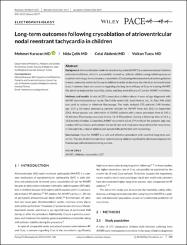| dc.contributor.author | Karacan, Mehmet | |
| dc.contributor.author | Çelik, Nida | |
| dc.contributor.author | Akdeniz, Celal | |
| dc.contributor.author | Tuzcu, Volkan | |
| dc.date.accessioned | 10.07.201910:49:13 | |
| dc.date.accessioned | 2019-07-10T19:50:52Z | |
| dc.date.available | 10.07.201910:49:13 | |
| dc.date.available | 2019-07-10T19:50:52Z | |
| dc.date.issued | 2018 | en_US |
| dc.identifier.citation | Karacan, M., Çelik, N., Akdeniz, C. ve Tuzcu, V. (2018). Long-termoutcomes following cryoablation of atrioventricular nodal reentrant tachycardia in children. Pace-Pacing and Clinical Electrophysiology, 41(3), 255-260. https://dx.doi.org/10.1111/pace.13277 | en_US |
| dc.identifier.issn | 0147-8389 | |
| dc.identifier.issn | 1540-8159 | |
| dc.identifier.uri | https://dx.doi.org/10.1111/pace.13277 | |
| dc.identifier.uri | https://hdl.handle.net/20.500.12511/2093 | |
| dc.description | WOS: 000426870600005 | en_US |
| dc.description | PubMed ID: 29318633 | en_US |
| dc.description.abstract | BackgroundAtrioventricular nodal reentrant tachycardia (AVNRT) is a common tachyarrhythmia substrate inchildren, which is successfully treated by catheter ablation using radiofrequency or cryothermal energy. In recent years, cryoablation (Cryo) using electroanatomical system guidance is more commonly preferred for use in children in order to decrease the risk of an atrioventricular block. However, there are concerns regarding the long-term efficacy of Cryo in treating AVNRT. We aimed to evaluate the feasibility, safety, and long-term efficacy of Cryo for AVNRT in children. Methods and resultsA total of 275 consecutive children above 4 years of age diagnosed with AVNRT were included in our study. The EnSite system (St. Jude Medical, Inc., St. Paul, MN, USA) was used to reduce or eliminate fluoroscopy. The study included 275 patients (148 females, age: 11.9 3.6 years) undergoing catheter ablation forAVNRT from July 2012 to September 2016. Acute success was obtained in all (100%) patients with a mean procedure time of 140 +/- 44 minutes. Fluoroscopy was used in only 12 (4.4%) patients. During a follow-up time of 25.6 +/- 13.5 months (median: 23 months),AVNRT recurred in 12 of 279 (4.4%) of the patients. Age, sex, number of Cryo lesions, and catheter tip size (6-mm vs 8-mm) were not predictive for recurrence. In nine patients, a repeat ablation was successfully performed with cryoenergy. ConclusionsCryo for AVNRT is a safe and effective procedure with excellent long-term outcomes. The use of electroanatomical systems during ablation significantly decreases exposure to fluoroscopy without compromising success. | en_US |
| dc.language.iso | eng | en_US |
| dc.publisher | Wiley | en_US |
| dc.rights | info:eu-repo/semantics/embargoedAccess | en_US |
| dc.subject | AVNRT | en_US |
| dc.subject | Children | en_US |
| dc.subject | Cryoablation | en_US |
| dc.subject | SVT | en_US |
| dc.title | Long-termoutcomes following cryoablation of atrioventricular nodal reentrant tachycardia in children | en_US |
| dc.type | article | en_US |
| dc.relation.ispartof | Pace-Pacing and Clinical Electrophysiology | en_US |
| dc.department | İstanbul Medipol Üniversitesi, Tıp Fakültesi, Dahili Tıp Bilimleri Bölümü, Çocuk Sağlığı ve Hastalıkları Ana Bilim Dalı | en_US |
| dc.authorid | 0000-0002-4375-2881 | en_US |
| dc.authorid | 0000-0002-8647-6055 | en_US |
| dc.authorid | 0000-0001-9008-4997 | en_US |
| dc.identifier.volume | 41 | en_US |
| dc.identifier.issue | 3 | en_US |
| dc.identifier.startpage | 255 | en_US |
| dc.identifier.endpage | 260 | en_US |
| dc.relation.publicationcategory | Makale - Uluslararası Hakemli Dergi - Kurum Öğretim Elemanı | en_US |
| dc.identifier.doi | 10.1111/pace.13277 | en_US |
| dc.identifier.wosquality | Q4 | en_US |
| dc.identifier.scopusquality | Q2 | en_US |


















